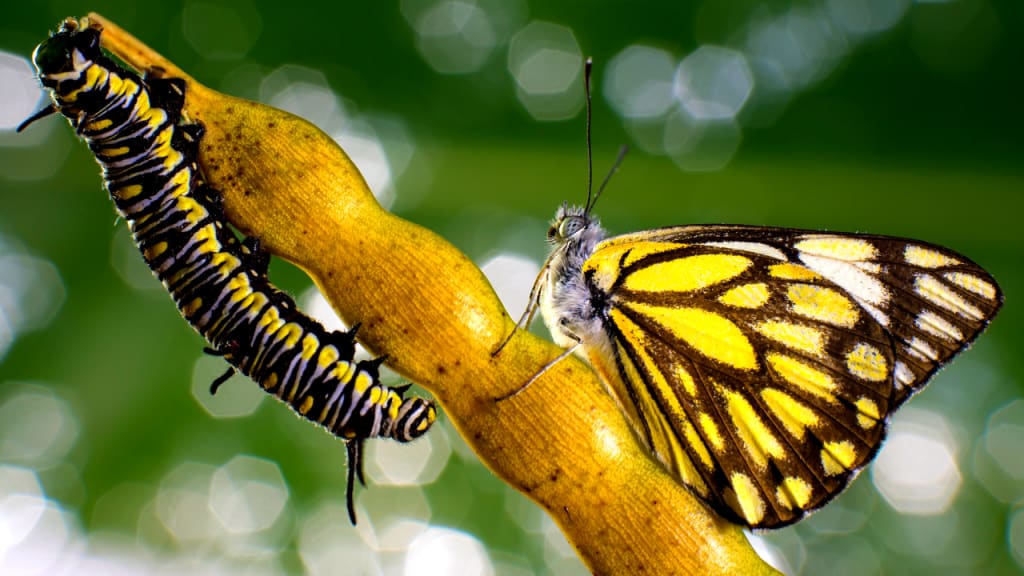Do All Caterpillars Turn Into Butterflies?
How these pesky insects turn into a lovely butterflies?

Caterpillars and butterflies lead very different lives. Caterpillars are often seen as pests, eating leaves in gardens and damaging crops. Butterflies, on the other hand, are admired for their beauty and grace.
So before getting rid of caterpillars in your garden, let’s find out - do all caterpillars turn into butterflies? The answer is a little more complicated than you might think. Let’s dig into this subject a little bit more.
What is Metamorphosis?
Metamorphosis is a transformation that occurs during the life cycle of many insects, amphibians, and reptiles. The process usually begins with an egg, which hatches into larvae.
The larvae then undergo a series of molts, shedding their skin as they grow. Once they reach maturity, they enter the pupal stage, during which their bodies undergo a radical change. The pupae eventually emerge as adults, with fully developed wings and reproductive organs.

In some cases, the metamorphosis is complete, and the adult will never return to its larval form.
However, in other cases, the adult may retain some characteristics of its larval stage, such as gills or vestigial tails. Regardless of the specific details, metamorphosis is an amazing process that allows animals to adapt to their changing environment.
What is Considered Incomplete Metamorphosis?
Incomplete metamorphosis is a type of developmental process that occurs in some insects. Most notably, it occurs in insects that belong to the order Hemiptera, which includes bugs, beetles, and grasshoppers.
This type of metamorphosis is characterized by a simple transformation from larva to adult. There is no pupal stage, and the larva develops directly into an adult. But, the process has some advantages over complete metamorphosis.
For example, since there is no pupal stage, the insect can begin reproducing more quickly. In addition, incomplete metamorphosis is less energy-intensive than complete metamorphosis, since the larva does not have to undergo a complete transformation.
However, incomplete metamorphosis also has some disadvantages. For example, since the larva and adult are fairly similar in appearance, the insect may be more susceptible to predators. In addition, the larva may be less capable of feeding itself than an insect undergoing complete metamorphosis.
As a result, incomplete metamorphosis can be a mixed blessing for insects that undergo this type of development.
How Does a Caterpillar Turn into a Butterfly?
The process of a caterpillar transforming into a butterfly is one of the most amazing feats in the natural world. It starts when the caterpillar hatches from an egg.

For the next few weeks, it will eat constantly, growing larger and shedding its skin several times. Once it has reached its full size, the caterpillar will attach itself to a branch and enter the pupal stage. During this time, its body will begin to break down and reform into that of a butterfly.
Finally, the butterfly will emerge from its cocoon, ready to take flight and begin the cycle anew. Each step in this transformation is essential for the survival of the species, and it is truly a remarkable sight to behold.
Do All Caterpillars Turn Into Butterflies?
It's amazing to think about the transformation that caterpillars undergo to become either butterflies or moths. It all starts with an egg, and the caterpillar that hatches from that egg is tiny.
But it won't stay tiny for long! The caterpillar will eventually stop producing the hormone that keeps it in the larval stage, and this leads to the formation of a cocoon or chrysalis. After spending time in the cocoon or chrysalis, the caterpillar will emerge as an adult butterfly or moth.
Many caterpillars become moths, but there are no exceptions to this rule - all caterpillars must transform into either a butterfly or a moth! It's truly amazing to think about the metamorphosis that these creatures go through in their lifetime.
Why Some Caterpillars Do Not Turn Into Butterflies?
Caterpillars are fascinating creatures because it is difficult to predict whether a caterpillar will develop into a butterfly or a moth. This is due to the fact that the features of both types of caterpillars are indistinct and difficult to distinguish.

For example, some caterpillars can only form chrysalises that transform them into dark-colored moths, whereas others can form cocoons that burst open to reveal the most vibrant butterflies. In either case, metamorphosis or total transformation is unavoidable.
However, many eggs do not hatch, and many caterpillars do not survive the larval stage. We can't expect to see a moth or a butterfly in these unfortunate circumstances. Nevertheless, the metamorphosis of a caterpillar into either a moth or butterfly is an amazing process to witness.
Summary
So, do all caterpillars turn into butterflies? The answer is no - not every caterpillar becomes a butterfly. In fact, there are quite a few different types of insects that go through a process called metamorphosis to change from their larval stage into an adult form.
But the transformation from a crawling caterpillar into a beautiful butterfly is one of nature's most amazing transformations, and it's definitely worth taking the time to watch!






Comments
There are no comments for this story
Be the first to respond and start the conversation.